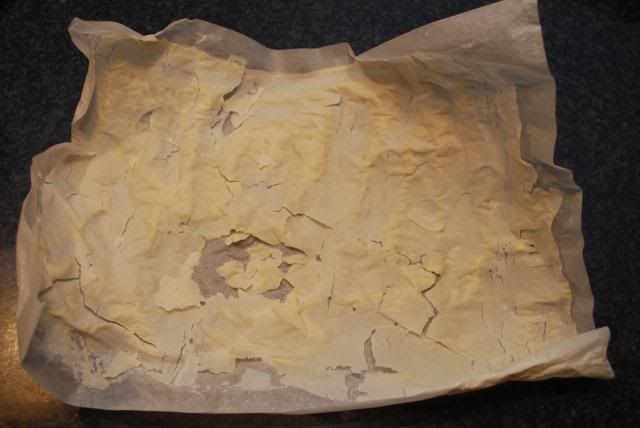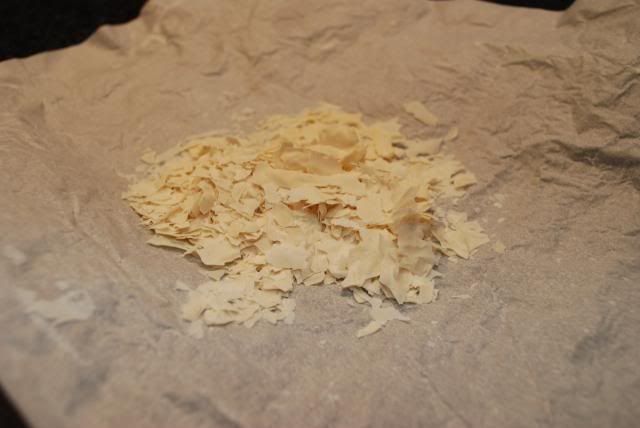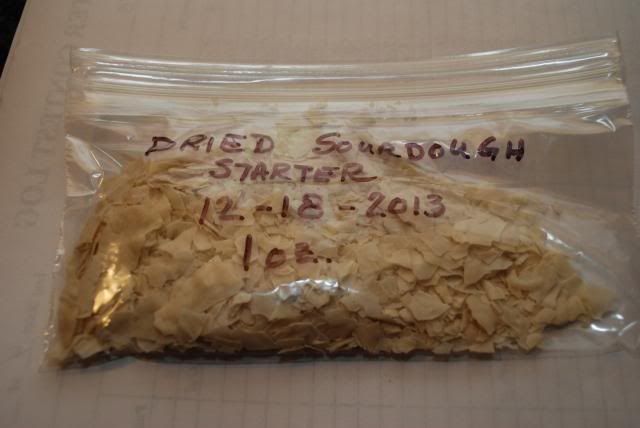I have had the same mother starter going since June 2008 when I created it with the pineapple juice method. A week ago I looked in the back of the fridge and remembered that I hadn't fed the starter for a few weeks, and made a mental note (big mistake for an old guy, LMAO) that I needed to do that. So 5 days ago I pulled out the jug, opened the lid, and was greeted with a mold cap that would do a penicillin scientist proud. I dissected the mess and tried to feed what was underneath the mold, but it was fruitless. I guess it was a little more than a couple of weeks since I last fed it, and the batch was deader than last Tuesday. I should have taken a picture, but I wasn't thinking about sharing my stupidity so soon.
Fortunately, about 2 years ago I dried a sheet of starter on parchment paper and put it in the freezer in a 1/2 pint jelly jar with a sealed lid. Over the past 5 days I managed to recreate my starter from 2 Tbs of dried starter, and will now pay closer attention to the feeding schedule. I also have a fresh sheet of starter drying in the oven with just the light bulb to keep it warm and dry it out, and will store another batch for future use and for sharing with friends who also bake sourdough bread.
Losing your starter doesn't have to be a total disaster if you plan ahead and store some dried starter. I'm back in business because of a little pre-planning, and have proved that dried starter will keep at LEAST for 2 years in the freezer if properly stored...and it's from the original mother starter!
Fortunately, about 2 years ago I dried a sheet of starter on parchment paper and put it in the freezer in a 1/2 pint jelly jar with a sealed lid. Over the past 5 days I managed to recreate my starter from 2 Tbs of dried starter, and will now pay closer attention to the feeding schedule. I also have a fresh sheet of starter drying in the oven with just the light bulb to keep it warm and dry it out, and will store another batch for future use and for sharing with friends who also bake sourdough bread.
Losing your starter doesn't have to be a total disaster if you plan ahead and store some dried starter. I'm back in business because of a little pre-planning, and have proved that dried starter will keep at LEAST for 2 years in the freezer if properly stored...and it's from the original mother starter!
You got lucky with the dried starter. Funny that your culture developed mold though, with the pH it usually has mold shouldn't develop. By way of experiment I removed part of my mother culture a couple of months ago and stored it in a small pot in my fridge without touching it for 9 weeks. It had a layer of luid on top when I opened it and took 12 hours to spring back after feeding but otherwise no problems. Hope I didn't invoke a curse upon myself b/c I'll be leaving for a full month and will do the same with my mother culture. Guess I'd better dry some and freeze that just in case.
Starters are nearly impossible to kill. I've had a contract out on mine since 1973 but has iived though every near death experience - and never broke a sweat :-) I have a dried specimen in the freezer and one in the cupboard and one not dried but frozen. The 6 P's were at work for you here I think. The 6 P's are - Prior, planning, prevents piss, poor performance in most things including killing starters.
Glad you were able to resurrect yours from the dead....I'm still making sandwich thins all the time by the way - all because of you!
Happy Baking JoeV!.
Yep, I have misused and abused my starter over the years, and it has always managed to come back to life in a short period of time. For the life of me I cannot figure what caused the mold, but I'm just glad I had the good sense to freeze some starter. Once this sheet dries, I'll freeze it in a new bottle. I highly recommend every serious baker to preserve some of their starter for a rainy day.
Glad you're still making the thins. We always have them in the freezer, and I jump between Italian, whole wheat and rye thins. it's all good.
Merry Christmas!
JoeV:
What is your process for drying and freezing starter?
-Dave
Take some parchment paper and smear a thin coat of vibrant starter with a flexible spatula. Try to keep it thin so it will dry faster. Put the coated sheet in the oven with the light on. That's enough warmth to dry the starter in about 6-12 hours depending on temperature and humidity.
When the sheet is fully dry, simply fold the paper onto itself and crush the starter with your hand until its crushed into small pieces, then pour it into a small zip-lock bag. Label and date the bag and put it in a sealed glass jar and store in the freezer until needed.
This batch made about 1 oz (29g) of dried starter, which is about 3-4T. You can make as many batches as you like to freeze or share with your friends. It only takes 1T of dried starter to begin a new batch, so this is enough for 3-4 batches.
[URL=http://smg.photobucket.com/user/flyfishohio/media/Breads/Dried%20Starter/Driedstarter12182013-1_zps003ba1f7.jpg.html] [/URL]
[/URL]
[URL=http://smg.photobucket.com/user/flyfishohio/media/Breads/Dried%20Starter/Driedstarter12182013-2_zps11ff168f.jpg.html] [/URL]
[/URL]
[URL=http://smg.photobucket.com/user/flyfishohio/media/Breads/Dried%20Starter/Driedstarter12182013-3_zpsf3eceec1.jpg.html] [/URL]
[/URL]
weeks since you last fed it? Maybe I misread that part, but that seems odd, usually starters are OK with such a time period. I will admit to not having too much experience with white flour or whole wheat starters, but my rye starter keeps for a month and a half without any problem.
It had been an indeterminate amount of time since the starter had been tended to. I have been extremely busy with my business, and have not done any sourdough baking for quite some time. Normally I would tend to the starter every 4-6 weeks when not being used for baking, but my bread baking has been "subsistence baking" using instant yeast for the past 3-4 months. Hopefully I will have more time for making some sourdough breads during the Christmas season, as my business traditionally slows at this time of year.
Starter is like a wife; both need loving on a regular basis if you plan on keeping them for the long term.
Wonder about the mold? I know mold, like most microorganisms(bacteria, yeasts, etc), are virtually everywhere, but how did it overwhelm this established, healthy starter in such a short period of time?
I keep about 35g(1.2 oz) of firm(50%) starter on hand, refrigerated. I did not use or feed it for over 9 months(because I preferred to bake with idy). I did not do anything to prepare it for such a long time of non use.
When I finally ran out of idy, I scraped about a teaspoon from the middle of the neglected starter. Fed it a teaspoon of flour and a teaspoon of water and let it sit for a day. Then started feeding/building it twice a day.
On the third day after having first scraped that teaspoon of starter, I was baking again and for 2 years since. Have not got around to buying any more idy yet. Just can't bring myself to buy the envelopes and haven't gotten by my source for a bulk package yet.
But yes, the drying and freezing method has been proven and practiced and posted about on TFL for many years. Don't know why there was debate about that.
Bulk IDY is readily available in 1# bricks for about $4-$5 at expensive joints like GFS and other restaurant supply shops in the Cleveland area. I buy IDY at Sam's club, and it's available at BJ's and COSTCO as well. It's packaged with (2) 1# bricks for $4.25 the last time I bought it. I keep a 4oz jar in the fridge, and the rest in a sealed mason jar in the freezer. The extra brick just sits in the pantry until needed, as it's vacuum sealed. I use at least 1# per year, and often more than that, so this bulk buying is good for me. Envelopes are the most expensive way to buy yeast.
Yes. Thanks.
Actually, the last time I bought some(1# SAF red), I paid only $2.69/lb. I just don't get out much to go there, or any other place that sells bulk. But yes, that's just the way I manage mine and a lb lasts me at least a year. I can actually count the 4 times in my entire life that I have bought yeast. 1-3 envelope strip, 1- 4 oz jar, and 2 - 1 lb bricks. I've only been baking my own breads about 4½ years.
Right now, I've got plenty of time for sd. Readily makeable, and free(never any discards). Still manage to make/bake a few pounds of bread and pizza a week.